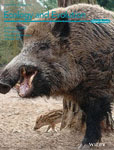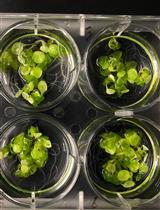- EN - English
- CN - 中文
Determination of Root Exudate Concentration in the Rhizosphere Using 13C Labeling
13C标记测定根际根系分泌物浓度
发布: 2019年05月05日第9卷第9期 DOI: 10.21769/BioProtoc.3228 浏览次数: 7374
评审: Joëlle SchläpferVenkatasalam ShanmugabalajiLaura Zanin
Abstract
One of the most remarkable metabolic features of plant roots is their ability to secrete a wide range of compounds into the rhizosphere, defined as the volume of soil around living roots. Around 5%-21% of total photosynthetically fixed carbon is transferred into the rhizosphere through root exudates. Until recently, studies on the quantity and quality of root exudates were conducted mostly under axenic or monoxenic in vitro conditions. Today, in situ assays are required to provide a better understanding of root exudates dynamics and role in plant-microbe interactions. By incubating plants with 13CO2 in situ for one week and quantifying 13C enrichment from the root-adhering soil using mass spectrometry, we were able to determine root exudate levels. Indeed, labeled substrate 13CO2 is converted into organic carbon via plant photosynthesis and transferred into the soil through root exudation. We assume that all 13C increases above natural abundance are mainly derived from exudates produced by 13C-labeled plants.
Keywords: Root exudates (根分泌物)Background
Through the exudation of a wide variety of compounds, plants communicate with the soil microbial community in their immediate vicinity, cope with herbivores, foster beneficial symbioses, change the chemical and physical properties of the soil, and inhibit the growth of competing plant species. Understanding how plants differ quantitatively in their root exudate patterns, according to their genotypes and traits as well as to environmental parameters and the soil microbial community is an exciting research challenge. This objective could be achieved by quantifying root exudate content using 13CO2 plant-labeling coupled with a 13C enrichment measurement from the root-adhering soil using mass spectrometry. This protocol was set up by using different plant species such as Poaceae, legumes (Medicago truncatula), Arabidopsis thaliana, and Monocotyledon plants such as maize and wheat. As rhizodeposition also depends on plant species, the collection period was after 10 weeks for Poaceae and 4 weeks for the rest. This method can be used with other species, for which the collection period must be set up according to what is known about the studied plant.
Materials and Reagents
- 1 mm mesh size for soil sieving (Fisherbrand tamis, France)
- Plastic pots for plant growing (7 x 7 x 6.4, black pots, France)
- 5 x 8 mm “Ultra Clean” tin capsules (Elemental Microanalysis, Okehampton, UK, catalog number: D1034)
- In the case of calcareous soils: 5 x 8 mm silver capsules (Elemental Microanalysis, Okehampton, UK, catalog number: D2009)
- Soil and seeds for plant growing
The soil used to set up this protocol was luvisol with no added nitrogen source collected at La Côte Saint-André (Isère, France) and which was continuously harvested with maize. It was a loamy soil composed of 16.2% clay, 45.4% loam and 28.4% sand, with a total nitrogen content of 1.9 g·kg-1 - Reference materials for 13C measurements: IAEA-CH3 (cellulose), IAEA-CH6 (sucrose) (Coplen et al., 2006) and partially 13C-labelled material [e.g., D-Glucose (3-13C, 99%)] (Eurisotop, Saint-Aubin, France, catalog number: CLM-1393-0.25)
- Calibration material for carbon (C) concentration measurements: aspartic acid (Elemental Microanalysis, Okehampton, UK, catalog number: B2042)
- Distilled water
- Liquid N2
- Pure 13CO2 (> 99% atom 13C; purchased from Cortec Net, Paris, France)
- In the case of calcareous soils: hydrochloric acid (HCl) 37% (CAS number: 7647-01-0, e.g., Sigma-Aldrich, Saint-Louis, MO, USA, catalog number: 30721-M)
Equipment
- 50 ml beaker
- Spatula and forceps
- Desiccator (Freeze-dryer) (Alpha 1-4 LSC, Martin Christ®, Osterode am Harz, Germany)
- Mixer mill grinder (Mixer Mill MM 200, Retsch®, Haan, Germany)
- Laboratory balance with a resolution of 0.01 mg or better (XP6 microbalance, Mettler Toledo, Greifensee, Switzerland)
- Isotope ratio mass spectrometer (Isoprime 100, Elementar UK Ltd., Cheadle, UK), coupled in continuous flow with an elemental analyzer (vario PyroCube in CN mode, Elementar Analysensysteme, Lagenselbold, Germany, or FlashEA 1112, ThermoElectron, Waltham, MA, USA)
- Growth chamber equipped for automatic control of light, temperature, moisture, evapotranspiration, irrigation and CO2 concentration
Software
- Isoprime 100 isotope ratio mass spectrometer operating software: Ionvantage® for Isoprime, build 1.6.1.0 (Elementar Analysensysteme, Lagenselbold, Germany)
- Elemental analyzer operating software (pyrocube Software v4.0.1 was used in this protocol, Elementar Analysensysteme, Lagenselbold, Germany)
Procedure
文章信息
版权信息
© 2019 The Authors; exclusive licensee Bio-protocol LLC.
如何引用
Simon, L. and Haichar, F. E. Z. (2019). Determination of Root Exudate Concentration in the Rhizosphere Using 13C Labeling. Bio-protocol 9(9): e3228. DOI: 10.21769/BioProtoc.3228.
分类
植物科学 > 植物生物化学 > 根系分泌物
环境生物学 > 植物 > 植物-微生物互作
您对这篇实验方法有问题吗?
在此处发布您的问题,我们将邀请本文作者来回答。同时,我们会将您的问题发布到Bio-protocol Exchange,以便寻求社区成员的帮助。
提问指南
+ 问题描述
写下详细的问题描述,包括所有有助于他人回答您问题的信息(例如实验过程、条件和相关图像等)。
Share
Bluesky
X
Copy link











